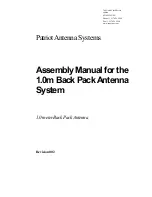
Antenna Installation
Tsunami
®
MultiPoint 10200 Series - Antenna Installation Guide
14
5. If required, adjust the direction of the antenna.
6. Tighten the nuts of the antenna to lock the antenna into its position.
7. Secure the cable along its complete length with a cable or electrical tape to relieve strain on the antenna connector. No
part of the cable should be allowed to hang free, especially the parts that are routed outside the building.
8. Weatherproof all the outdoor connectors. See
.
Ensure you follow the below guidelines while using the antenna cable:
•
The entire cable used must be secured and no part of the antenna cable should be allowed to hang free, precisely the
outdoor cable parts.
•
The antenna cable and cable connectors are not designed to withstand excessive force.
•
Do not use the connectors like ‘cable grips’, to pull the cable through raceways or conduits.
— Do not use the cable connector to support the weight of the cable during or after installation.
— Do not use any tool to tighten the connectors.
•
Always seal the connectors using the weatherproofing tape.
•
Avoid any water or moisture entering the cable, as it impacts the performance of the wireless link.
•
Prior to sealing the outdoor connectors and permanently securing the cable to the wall with cable ties and wall hooks,
assure that the components that are installed are functioning properly.
Antenna Cable Routing
The antenna cable must be routed and fixed in such a way, that the installation technicians have a clear passage area. All the
connectors that are located outdoor must have a weatherproof seal. We recommend you to seal the connectors only after
completing the final radio test. See
1.2.4.2 Connecting the Surge Arrestor and Ethernet / Power cables
Perform the following steps to ensure proper surge protection, and ethernet or power cabling:
•
Connect the surge arrestor near the outdoor device with a CAT5e ethernet cable (properly ground it near to the cable
ingress point of the building, complying with the local electrical code requirements).
•
Connect the RJ 45
Data In / LAN-IN / IN
port on the POE (power injector) and the network interface card of the
personal computer with a Cat5e ethernet cable.
•
Plug one end of the Cat5e ethernet cable into the ethernet port of the surge arrestor (near building ingress point) and
connect the other end of the cable to the
Data & Power Out / PWR LAN-OUT / OUT
port on the POE. Ensure that
the cable connector is latched securely.
•
Connect the remaining ports on both the surge arrestors (one near the outdoor device and other at the building
ingress point) with an RJ 45 terminated cable.
:
It is mandatory to install an approved lightening surge protector at the building ingress point. If the device is installed
in a region subjected to violent thunderstorms or severe weather conditions, then installation of an additional
: Avoid over-tightening of the connector, nuts and screws that are used to mount the antenna, to
protect the antenna and device from getting damaged.
IMPORTANT! Ensure to loop the cable before entering the premise to prevent water ingress.















































